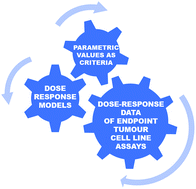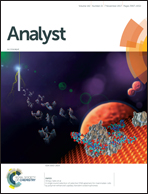Mathematical models of cytotoxic effects in endpoint tumor cell line assays: critical assessment of the application of a single parametric value as a standard criterion to quantify the dose–response effects and new unexplored proposal formats†
Abstract
The development of convenient tools for describing and quantifying the effects of standard and novel therapeutic agents is essential for the research community, to perform more precise evaluations. Although mathematical models and quantification criteria have been exchanged in the last decade between different fields of study, there are relevant methodologies that lack proper mathematical descriptions and standard criteria to quantify their responses. Therefore, part of the relevant information that can be drawn from the experimental results obtained and the quantification of its statistical reliability are lost. Despite its relevance, there is not a standard form for the in vitro endpoint tumor cell lines’ assays (TCLA) that enables the evaluation of the cytotoxic dose–response effects of anti-tumor drugs. The analysis of all the specific problems associated with the diverse nature of the available TCLA used is unfeasible. However, since most TCLA share the main objectives and similar operative requirements, we have chosen the sulforhodamine B (SRB) colorimetric assay for cytotoxicity screening of tumor cell lines as an experimental case study. In this work, the common biological and practical non-linear dose–response mathematical models are tested against experimental data and, following several statistical analyses, the model based on the Weibull distribution was confirmed as the convenient approximation to test the cytotoxic effectiveness of anti-tumor compounds. Then, the advantages and disadvantages of all the different parametric criteria derived from the model, which enable the quantification of the dose–response drug-effects, are extensively discussed. Therefore, model and standard criteria for easily performing the comparisons between different compounds are established. The advantages include a simple application, provision of parametric estimations that characterize the response as standard criteria, economization of experimental effort and enabling rigorous comparisons among the effects of different compounds and experimental approaches. In all experimental data fitted, the calculated parameters were always statistically significant, the equations proved to be consistent and the correlation coefficient of determination was, in most of the cases, higher than 0.98.



 Please wait while we load your content...
Please wait while we load your content...